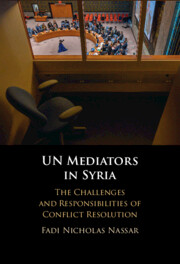3 - The Quiet Negotiator
Published online by Cambridge University Press: 16 May 2024
Summary
This chapter examines Lakhdar Brahimi’s agency as a mediator in Syria, while also clarifying how his strategic perceptions affected his mediation behavior. Adopting a slightly different structure than its predecessor, it consists of two sections. The first assesses the mediator’s agency in determining the main mediation policies and responses from his appointment on August 17, 2012 till his resignation on May 13, 2014. During this period, five policy responses stand out—the Eid al Adha Ceasefire, the May 7 Communiqué, responding to the use of chemical weapons, Geneva II, and the mediator’s resignation. A first-level analysis is applied to clarify the mediator’s input on each. The second section moves to explain the dynamics behind his decision-making. To do so, it focuses on the mediator’s perceptions regarding the four categories outlined in the contingency model—the identity of the mediator, the context of mediation, the parties, and the process of mediation. Such analysis helps shed light on the links between the mediator’s perceptions on these four categories and his decision-making in Syria as well as the formulation of more generalizable principles.
- Type
- Chapter
- Information
- UN Mediators in SyriaThe Challenges and Responsibilities of Conflict Resolution, pp. 91 - 150Publisher: Cambridge University PressPrint publication year: 2024



